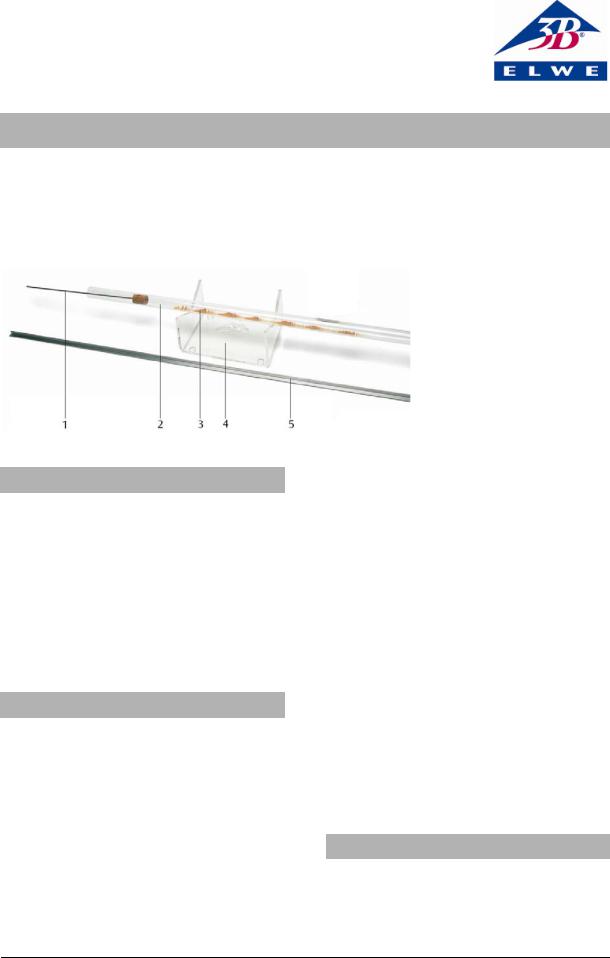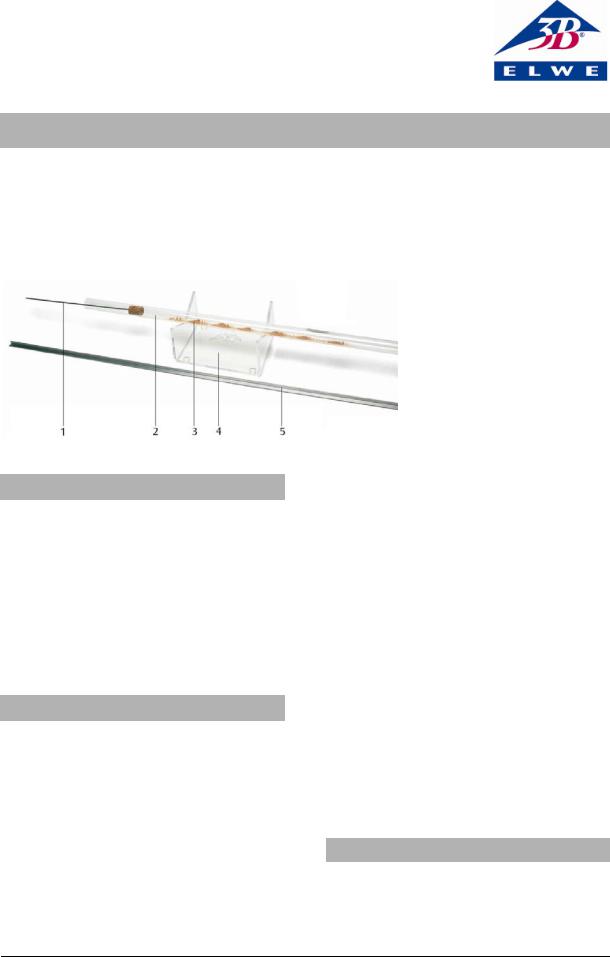3B Scientific Kundts Tube User Manual [en, de, es, fr, it]

3B SCIENTIFIC® PHYSICS
Kundt’sches Rohr U8432845
Bedienungsanleitung
10/07 ALF
1 Abstimmschieber
2 Kundt’sche Röhre
3 Korkmehl
4 Ständer (nicht im Lieferumfang enthalten)
5 Einfüllschiene
1.Sicherheitshinweise
•Glasröhre bruchsicher aufbewahren.
•Glasröhre keinen mechanischen Belastungen aussetzen.
•Abstimmschieber beim Einbzw. Ausschieben nicht verkanten.
•Gerät nicht mehr benutzen, wenn auch nur kleinste Beschädigungen am Glaskörper vorhanden sind.
•Gerät vor Feuchtigkeit und Staub schützen.
2. Beschreibung
Die Kundt’sche Röhre ermöglicht die Darstellung der Verteilung von Schwingungsknoten und –bäu- chen in einer stehenden Schallwelle mit Hilfe von Korkmehl. Es kann gezeigt werden, dass sich stehende Wellen ausbilden, wenn die Resonanzbedingung für die Länge s der in der Röhre schwingenden Luftsäule und für die Wellenlänge λ des Schalls erfüllt ist:
s = n λ/2 bei Reflexion am offenen Ende mit einem Schwingungsbauch
s = (2n+1)λ/4 bei Reflexion am geschlossenen Ende mit einem Schwingungsknoten (n = 1, 2….n).
Die Wellenlänge wird bestimmt aus der Anzahl n der Schwingungsknoten und dem Abstand a zwi-
schen dem ersten und letzten Schwingungsknoten
λ = 2a/(n − 1).
Der Abstimmschieber mit Korkstempel dient zum Verschließen der Röhre und zur Abstimmung der wirksamen Rohrlänge auf die Schallfrequenz.
Als Schallquellen dienen eine Trillerpfeife, eine Stimmgabel oder ein Lautsprecher mit Funktionsgenerator.
Der Trichter verringert den Wellenwiderstand an der Rohröffnung. Dadurch gelangt mehr Schallenergie in die Röhre.
2.1 Lieferumfang
1 |
Glasröhre |
1 |
Abstimmschieber |
1 |
Trichter |
1 |
Trillerpfeife |
1 |
Einfüllschiene |
3. Technische Daten
Röhre: |
600 mm |
Innendurchmesser: |
17 mm |
Wandstärke: |
1,5 mm |
Abstimmschieber: |
280 mm x 3mm Ø |
1

4. Bedienung
Zur Durchführung der Versuche sind folgende Geräte zusätzlich erforderlich:
1 |
Stimmgabel 1700 Hz |
U8431020 oder |
1 |
Druckkammerlautsprecher |
U8432680 mit |
1 |
Funktionsgenerator |
U8533510 |
|
Korkmehl |
U8432850 |
1 Maßstab, 1 m |
U8401550 |
|
1 |
Ständer für Spulen |
U8496150 |
•Mittels der Einfüllschiene eine kleine Menge Korkmehl in die Röhre einfüllen.
•Die leicht geneigten Röhre vorsichtig schütteln, bis das Korkmehl gleichmäßig über die gesamte Länge der Röhre verteilt ist.
•Kundt’sche Röhre so auf den Ständer platzieren, dass der Korkmehlstreifen unten ist.
•Röhre langsam um die Längsachse drehen, so dass auch die Wandung bestäubt ist.
•Zur Wellenlängenbestimmung Röhre mit Trichter bestücken.
•Zur Bestimmung der Resonanzbedingung ohne Trichter experimentieren.
Hierbei ist der Einsatz der Stimmgabel 1700 Hz empfehlenswert. Sie liefert die Resonanzwellenlänge λ von 0.2 m für die Röhre von 0.6 m. Es ergeben sich Schwingungsbäuche an beiden Enden bei Reflexion am offenen Ende oder Schwingungsknoten bei Reflexion am geschlossenen Ende.
•Schallquelle unmittelbar am Röhrenende positionieren.
•Bei Einsatz der Trillerpfeife Pfeife quer zur Röhre halten, um zu verhindern, dass beim Anblasen Luft in die Röhre strömt.
•Bei Einsatz der Stimmgabel diese kräftig anschlagen und direkt mit der Zinke in Schwingungsrichtung zur Öffnung vor die Röhre bzw. den Trichter halten.
•Bei Einsatz des Lautsprechers Frequenz am Funktionsgenerator zum Auffinden der Resonanzfrequenz langsam verändern. Nutzbarer Bereich zwischen 600 Hz und 8000 Hz.
•Zur Abstimmung der geschlossenen Röhre auf die Resonanzlänge Abstimmschieber langsam verschieben.
Elwe Didactic GmbH • Steinfelsstr. 6 • 08248 Klingenthal • Deutschland • www.elwedidactic.com 3B Scientific GmbH • Rudorffweg 8 • 21031 Hamburg • Deutschland • www.3bscientific.com Technische Änderungen vorbehalten
© Copyright 2007 3B Scientific GmbH

3B SCIENTIFIC® PHYSICS
Kundt's tube U8432845
Instruction sheet
10/07 ALF
1 Movable plunger
2 Kundt's tube
3 Cork powder
4 Stand (not included)
5 Refill rail
1.Safety instructions
•Store the glass tube in a safe place where it cannot be exposed to danger of shocks or breaking.
•Do not expose the glass tube to any mechanical stress or strain.
•Do not bend the movable piston while pushing it in or pulling it out.
•Do not use the apparatus, if even the slightest damage is discovered on the glass tube.
•Protect the apparatus from humidity and dust.
2. Description
By employing cork dust, a Kundt’s tube is used to demonstrate the distribution of nodes and antinodes in a standing sound wave. Using the apparatus, it is also possible to demonstrate that standing waves are formed when a resonance condition is fulfilled for sound wavelength λ and length s of the vibrating air column in the tube such that:
s = n λ/2 for reflected waves with antinodes at the open end,
s = (2n+1)λ/4 for reflected waves with nodes (n = 1, 2….n) at the closed end.
The wavelength can be determined from the number of nodes n and the distance a between the first
and last nodes
λ = 2a/(n − 1).
The rod with the cork plunger seals the tube and is used for changing the effective tube length to tune the frequency of the resonant sound waves.
A whistle, a tuning fork or a loudspeaker driven by a function generator can be used as a sound source.
A funnel-shaped horn reduces the wave impedance at the opening of the tube. As a result, more sound energy can be introduced into the tube.
2.1 Scope of delivery
1 Glass tube
1 Movable piston
1 Horn
1 Whistle
1 Refill rail
3. Technical data
Tube: |
600 mm |
Internal diameter: |
17 mm |
Glass thickness: |
1.5 mm |
Movable plunger: |
280 mm x 3 mm dia. |
1

4. Operation
In order to conduct the experiments, the following apparatus is additionally required:
1 |
Tuning fork 1700 Hz |
U8431020 or |
1 |
Pneumatic loudspeaker |
U8432680 with |
1 |
Function generator |
U8533510 |
|
Cork powder |
U8432850 |
1 |
Metre scale |
U8401550 |
1 |
Stand for coils |
U8496150 |
•Use a refill rail to introduce a small quantity of cork dust into the tube.
•Slightly tilt the tube and shake it gently till the cork dust has uniformly spread throughout the length of the tube.
•Position the Kundt’s tube on the stand so that the strip of cork dust is at the bottom.
•Slowly rotate the tube along its length in order to spread the cork dust along the walls too.
•For determining the wavelength, fit the tube with a horn.
•For determining resonance conditions, conduct the experiment without a horn.
It is recommended that a 1700-Hz tuning fork be used. The fork produces a resonant wavelength λ of 0.2 m for the 0.6-m tube. When the wave is reflected at the open end, antinodes are produced at both ends. When the wave is reflected at the closed end, nodes are produced at both ends.
•Position the sound source right at the end of the tube.
•If blowing a whistle, make sure that it is perpendicular to the tube. This is necessary to prevent any air from entering the tube.
•When using a tuning fork, strike it and quickly hold it with its prongs in the direction of vibration in front of the opening of the tube or the horn.
•When using a loudspeaker, gradually change the frequency on the function generator to identify the resonance frequency. Effective range: between 600 Hz and 8000 Hz.
•To tune a closed tube to the resonant length, gradually move the movable plunger.
Elwe Didactic GmbH • Steinfelsstr. 6 • 08248 Klingenthal • Germany • www.elwedidactic.com 3B Scientific GmbH • Rudorffweg 8 • 21031 Hamburg • Germany • www.3bscientific.com Subject to technical amendments
© Copyright 2007 3B Scientific GmbH
